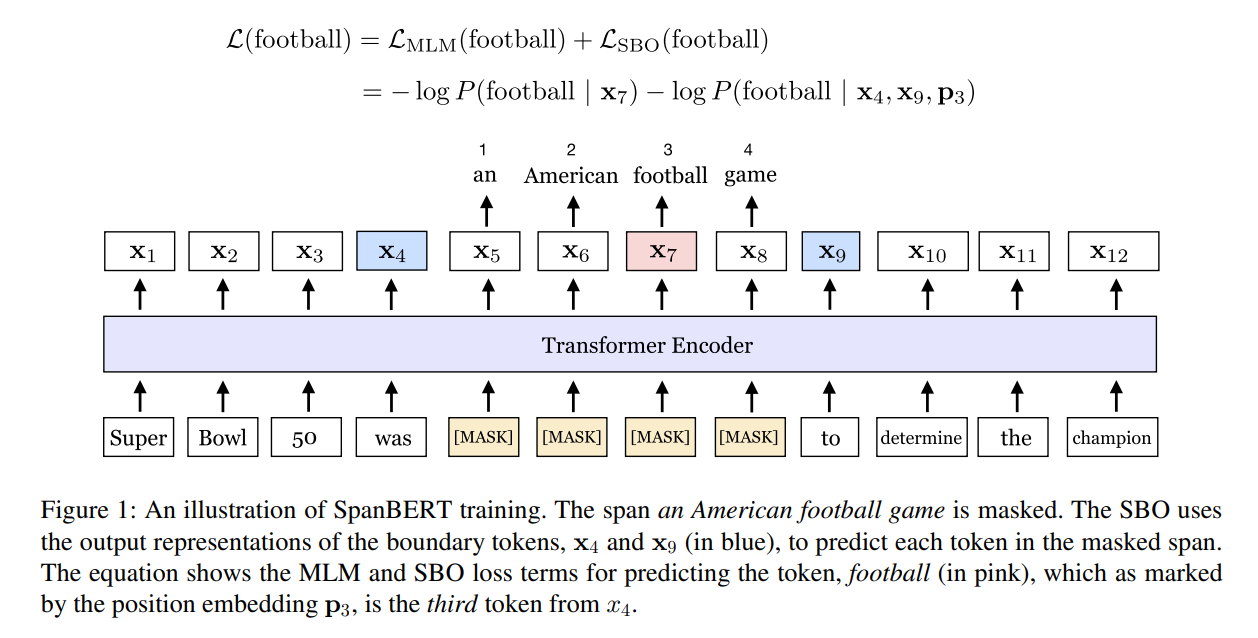This is a brief summary of paper for me to study and organize it, SpanBERT: Improving Pre-training by Representing and Predicting Spans (Joshi et al., TACL 2019) that I read and studied.
They said that
pre-training methods like BERT have shown strong performance gains using self-supervised training that masks individual words or subword units. However, many NLP tasks involve reasoning about relationships between two or more spans of text.
So they proposed the SpanBERT, a pre-training method that is designed to better represent and predict spans of text. It differs from the BERT in the masking scheme and the training objectives.
-
The masking scheme: masking randome contiguous spans rather than random individual tokens using geometric distribution.
-
The training objectives: using a novel span-boundary objective(SBO) to train model to predict the entire masked span from the observed tokens at its boundary.
In other words, they observed that single-sentence trining works considerably better than bi-sequence training with next sentence prediction (NSP), thus the extend the BERT in masking sheme and training objectives as follow:
They modified two training schemes, which is maked language model (MLM) and next sentence prediction (NSP), in BERT.
For MLM also known as a cloze task, given a seuqence of words or sub-word tokens \(X = (x_1, …, x_n)\), MLM is a task to predict missing tokens in a sequence.
to train MLM in BERT, when a subset of tokens \(Y \subseteq X\) is sampled and subsituted with a different set of tokens, Y accounts for 15% of the tokens in \(X\); of those, 80% are replaced with [MASK], 10% are replaced with a random token (according to unigram distribution), and 10% are kept unchanged.
The BERT predicts the original tokens in \(Y\) from the modified input.
When they train SpanBERT, as in BERT, they also mask 15% of input tokens in total: subsitituting 80% of the masked tokens with [MASK], 10% with random tokens, and 10% with the original tokens. However, they perform this masking scheme as span-level and no for each token individually.
When sampling the spans of text, they sample the span’s length from a geometic distribution in not subwords tokens but a sequence of complete words.
For NSP known as predicting whether two sequences \(X_A, X_B\) is direct continuation, they remove the NSP from SpanBERT, instead they sample a single full-length sequence (i.e. a single contingous segment) up to \(n=512\) tokens, rather than two half-segments that sum up to n tokens together in BERT.
In addition to those, They introduced the Sapn boundary Objective (SBO).
inspired span selection models makeing a fixed-length representation of a span using its boundary tokens (start and end token), they used a span represenation with start and end token.
since they want to make the span representation summarize as much of the internal span content as possible, they introduce a span boundary objective that involves predicting each token of a masked span using the external boundary tokens \((x_{s-1}, x_{e+1})\) in a masked span and the position embedding \(p_i\) of the target token .
Specifically, given a masked span \(((x_s, … x_e) \in Y\), where \((s,e)\) indicates its start and end position, the span reprensentation is :
\[y_i = f(x_{s-1}, x_{e+1}, p_i)\]In their work, they used represenation function \(f(\cdot)\) as a 2-layer feed-forward network with GeLU activations.
In their experiment, they found those trends:
-
The next sentence prediction(NSP) in BERT’s pre-training objectives hurt the performance on downstream tasks comparing with single sentence BERT(in Section 6.2).
-
the improvement factors of the performance in SpanBERT:
-
Masking contiguous random spans than rather than random tokens.
-
Training the span boundary representations to predict the entire content of the masked span, without relying on the individual token representation within it.
-
For detailed experiment analysis, you can found in SpanBERT: Improving Pre-training by Representing and Predicting Spans (Joshi et al., TACL 2019)
The paper: SpanBERT: Improving Pre-training by Representing and Predicting Spans (Joshi et al., TACL 2019)
